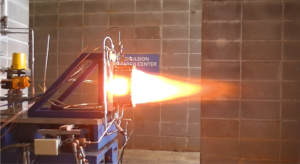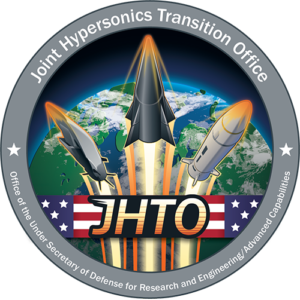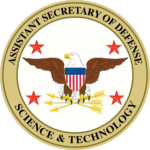The Department of Defense today announced the publication of a list of foreign entities that have been confirmed as engaging in problematic activity as described in Section 1286 of the […]
UCAH participant student interns with Reaction Engines
University of Alabama in Huntsville junior, Jared Sauer discusses his passion for propulsion and how being a student participant of the University Consortium for Applied Hypersonics connected him with a recent internship with Reaction Engines.
Hypersonic materials research led by Georgia Institute of Technology
The Georgia Institute of Technology is leading the way in better hypersonic sensor systems and safer flight with hypersonic materials research.
Study combines solid-fuel ramjet, rotating detonation engine technology at University of Alabama in Huntsville
Researchers at The University of Alabama in Huntsville are combining solid fuel research with rotating detonation engine technology to provide high-efficiency air-breathing propulsion for hypersonic technology.
The University of Texas at San Antonio leads materials separation study
The separation of materials moving at hypersonic speeds is a common challenge in hypersonic flight. Using modeling and experimental measures, a team from The University of Texas at San Antonio is leading research to address this aerodynamic issue.
University of Central Florida receives award from Department of Defense
A team from the University of Central Florida, a University Consortium for Applied Hypersonics university partner, is leading a project to study electromagnetic waves in hypersonic conditions to help refine hypersonic guidance, communications and control.
Student networking event held at Aviation Forum
The University Consortium for Applied Hypersonics is hosting a student and industry networking event as a part of their workforce development strategy at the only comprehensive aviation conference in the United States.
University Consortium for Applied Hypersonics Spring Forum: Leaping ahead
The recent University Consortium for Applied 2022 Spring Forum was centered on science and technology planning and “leap ahead” technology. The forum was held March 30-31 with 225 people attending panels and keynotes that showcased the competition in hypersonic technologies.
Historical Meeting Between Government and Defense Industry to Discuss Hypersonics Future
A recent meeting of top pentagon officials and defense industry executives met to discuss hypersonic weapons development and the 2023 budget for U.S. defense. A huge focus of this roundtable […]
U.S. Hypersonics Focus Should be Offense and Scientific Breakthroughs in Response to Chinese Strides in Hypersonics
In the midst of various United States government, academic, and industry projects exploring and pursuing hypersonic technology for defense, Gillian Bussey, director of the Defense Department’s Joint Hypersonics Transition Office […]
United States Army, Navy, and Office of the Secretary of Defense to Share Best Practices for Hypersonics with Air Force
The Pentagon’s first hypersonic weapon should be operational in “a year or two” says Gillian Bussey, the director of the Joint Hypersonic Transition Office a Department of Defense office. This […]
JHTO Sponsored “Need For Speed” Hypersonic Video Contest Winners
Need for Speed Hypersonic Video Contest hosted by University of Virginia Engineering in collaboration with University of Tennessee Space Institute and the University Consortium for Applied Hypersonics, and funded by […]
Department of Defense’s Joint Hypersonics Transition Office announces inaugural University Consortium for Applied Hypersonics awardees
BRYAN-COLLEGE STATION, Oct. 5, 2021—Proposals from 18 U.S. university-led research teams from the University Consortium for Applied Hypersonics (UCAH), totaling $25.5 million, were selected as awardees for prototyping contracts by […]
Joint Hypersonics Transition Office (JHTO) Corner with Dr. Gillian Bussey – “Looking Back and Looking Forward”
A year ago, we were in the final stages of bringing the University Consortium to life. Working with the Texas A&M Engineering Experiment Station, we were putting the final touches […]
Joint Hypersonics Transition Office (JHTO) Corner with Dr. Gillian Bussey – Q2 Updates
In the 8 months since the UCAH was established we have accomplished a great deal together. We built a strong, inclusive, and collaborative organization to achieve the goals congress set […]









![In the midst of various United States government, academic, and industry projects exploring and pursuing hypersonic technology for defense, Gillian Bussey, director of the Defense Department’s Joint Hypersonics Transition Office notes that China has long been pursuing hypersonic and “near space” weapons and technology for a number of years now and the United States Department of Defense needs to “focus on offense, first, because a good offense is the best defense—and offense is a lot easier.” This race for hypersonic defense includes small are large weapons as mentioned by Mark Lewis who is the executive director of the National Defense Industrial Association’s Emerging Technologies Institute who urges the endurance needed in this race for hypersonics “This can’t be a few years’ effort [where] we deploy a couple of systems, and then move on Because this is the future of warfare and we need to be in this race.” There are many different United States industry, universities and military resources being teamed to create hypersonic defense solutions currently and there are still many scientific breakthroughs to come in the field of hypersonics. Read more about this on Defense One.](https://hypersonics.tamu.edu/wp-content/uploads/2022/02/GettyImages-1146899896-300x200.jpg)




